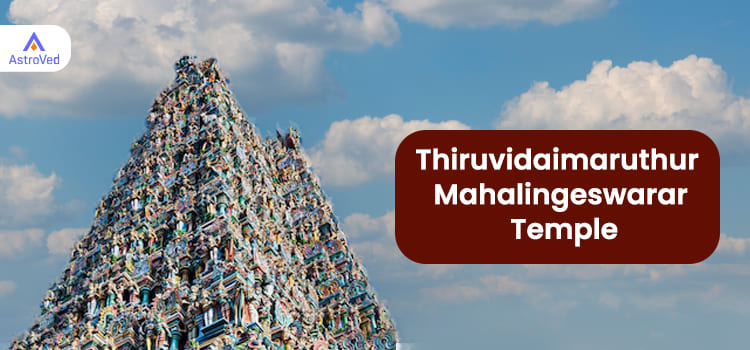This famous Temple of Tamil Nadu is dedicated to Lord Shiva. Here, he is worshiped as Mahalingeswarar or Mahalinga Swamy in the Lingam form. Thiruvidaimaruthur village is about 8 km from the holy town of Kumbakonam, where Shiva is enshrined with his consort, Sri Brihatasundaragujambigai. This Temple, lying on the banks of river Kaveri, is significant as one of the ‘Pancha Kshetrams’ that houses 5 Lingams in the same complex. While the principal Lingam, the presiding deity, is in the center of the Temple, the other 4 are in the 4 cardinal directions within the precinct itself.
The term Marudhur of Thiru Vidai Marudhur comes from the name of the holy tree Marudha Maram. Since this place was full of these Marudhu trees, the village assumed the name Marudhur and later became Thiruvidai Marudhur. This Marudha Tree, also known as the Arjuna Tree, happens to be the Sthala Vriksha, the Sacred Tree of this Temple.
Thiruvidaimaruthur Mahalingeswarar Temple Legend
According to scriptures, the mythical pot Kumbha, containing the seeds of all species on earth, flowed in the waters of a deluge and came to a halt in the place that is presently the holy town of Kumbakonam. In the process, the drops of Divine nectar the pot contained, spilled in five locations around Kumbakonam, one of which is Thiruvidaimaruthur, where Mahalingeswarar Temple stands today.
Another legend associates this Temple with relieving a king of the terrible Brahmahatya Dosha. This affliction incurs due to the killing of a Brahmin and is considered a heinous crime with catastrophic consequences. According to the story, King Varaguna Pandian’s horse accidentally trampled upon a Brahmin and killed him. With Brahmarakshas, the spirit of the dead person of the affliction, chasing him, the king ran into the Thiruvidaimaruthur Mahalingeswarar Temple to escape the wrath of the mighty spirit and took shelter in the lord. While the affliction that could not enter the Temple waited for the king just outside, the king, after his prayers, left the Temple through its other entrance. So it is said that the Brahmarakshas is still waiting at the first entrance for the king, who had escaped from it by Divine grace through the other entrance! As if to vouch for this story, we can find a sculpture of ‘Chola Brahma Hathi,’ a demonic form, in one of the inner tower gateways of the Temple. Even today, it is a practice for the devotees to enter the Temple for worship through one entrance and go out through the other.
The name of the principal deity, Maha Linga Eshwara, literally means Shiva, the great Lingam. According to mythology, Shiva, as the fierce Rudra, emanated from the heart of Goddess Mookambika and also appeared as a flame to satisfy the desires of Sage Agastya and other sages who were doing penance. Besides, a host of deities, including Vishnu, Lakshmi, Brahma, Saraswati, Parvati, Vinayaka, Muruga, and the celestial king Indra’s elephant Airavata are said to have worshiped him here.
History, Structure, and Architecture of the Thiruvidaimaruthur Temple
This Temple is one of the largest in Tamil Nadu, with 3 circumambulatory passages and 4 towers in 4 directions. We learn from the numerous Temple inscriptions that many royal dynasties like the Cholas, Pandyas, Vijayanagar kings, Thanjavur Nayaks, and Marathas have contributed to its construction, expansion, and maintenance. While archeologists attribute the oldest of the masonry structures here to the Chola kings of the 9th century CE, there are many later period expansions and additions, including the imposing towers, one of which is the 5-tiered Rajagopuram (principal tower), which have extended up to the Thanjavur Nayak rule of the 16th century.
The Temple has many shrines, the prominent among them being the east-facing sanctum of the presiding deity Mahalingeswara Swamy and the shrines of Goddess Bruhat Sundara Kuchaambika and Devi Mookambigai. Many pillared halls studded with sculptures and carvings dot the complex. Here, the second of the 3 precincts (circumambulatory passages) of the Vijayanagara period is worth mentioning for its exquisite sculptures. A stone chariot with 12 pillars remains a notable work here, where each pillar denotes one of the 12 Rasis/Lagnas.
There are five Temple tanks, all inside the Temple complex itself: the Karunyamrudha Theertham, Soma Theertham, Kanaka Theertham, Kalyana Theertham, and Iravatha Theertham. The Temple also has a replica of Mount Meru.
Religious Significance of Thiruvidaimaruthur Mahalingeswarar Temple
Sacred texts hold this Mahalingeswarar Temple of Thiruvidaimaruthur as holy as the famous Temple of the sacred Kasi (Varanasi). Many Shaivite saints, the Nayanmaars, like Appar and Sundarar, have visited this Temple and revered Mahalingeswarar through their devotional hymns, known as the Thevaram composition of the 7th/ 8th century. The famous 9th-century saint-poet Manikkavachagar has also sung in praise of this Temple and its deity.
While they celebrate festivals like other Shiva Temples here, which include Shivaratri, Deepavali, and Karthigai Deepam, Thai Poosam remains the biggest festival of the Temple, celebrated for 10 days during January-February. The processional deities of the Lord and the Goddess are taken daily in processions in the streets around the Temple on various mounts during these Days. The car festival is the grandest of these processions when the deities are pulled in a massive 89-foot tall chariot, one of the biggest in Tamil Nadu.
It is believed that going around the Temple passages and praying to Mahalinga Swamy can cure many illnesses and restore health. Devotees claim that many with mental disorders have become alright by circumambulating the corridors. According to beliefs, circumambulating the passage Ashwamedha Prakaram can help accrue merits of performing the highly efficacious Ashwamedha Yagnya while going around the Pranava Prakaram can even lead devotees to salvation.
